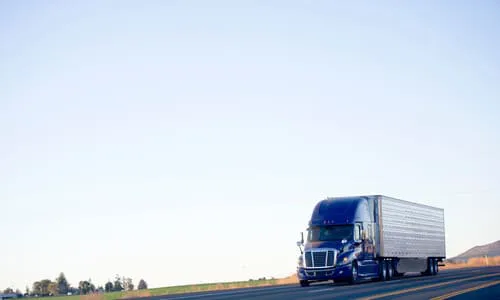 Trucks keep the economy in California humming along. Semi trucks, tankers, and other large commercial vehicles on our highways are familiar sights.
Trucks keep the economy in California humming along. Semi trucks, tankers, and other large commercial vehicles on our highways are familiar sights.
We take for granted that we must share the roads with these behemoths, but an accident shows us with sudden clarity just how dangerous they can be.
There are many different ways a serious — and often fatal — collision can happen with a large truck in California. Most often, they occur on divided highways, but they also happen at intersections and even on crowded one-way streets.
After the shock of the accident itself, injury victims will often endure greater challenges in paying for the aftermath. Hospital bills, lost work income, vehicle repairs, and other losses can all add up, but the good news is that you may have options.
By pursuing an injury claim with the help of a California truck accident lawyer from Singh Ahluwalia Attorneys at Law, you can fight for the maximum amount of compensation available.
Below, we have outlined some of the most common ways that truck accidents can happen. Regardless of whether or not you see your particular situation listed, we may be able to help.
Call 559-878-4958 or contact us online to schedule a free case review and consultation with an experienced California trucking accident attorney team near you.
How Common Are California Semi Truck Accidents?
A Statewide Integrated Traffic Records System (SWITRS) report on California from 2020 reveals that there were over 143,476 injury-causing accidents in the state that year and 3,672 fatal crashes. Looking just at truck accidents in the state, a data dashboard from the U.S. Department of Transportation (DOT)[1] shows that there were 3,715 injury-causing truck accidents and 438 fatal crashes in 2020.
By cross-comparing these numbers, we find that while large commercial vehicles were involved in just 2.5% of injury crashes in California, they were present in nearly 12% of fatal accidents. So, while collisions with trucks are relatively rare, including those that cause injuries, these accidents are also disproportionately fatal.
As for the type of truck, 38% of all large commercial vehicles involved in accidents in California from 2020–2023 were recorded as having a “Van/Enclosed Box” body, which includes trucks hauling semi-trailers. “Other” was the next-most common body type recorded (which includes crashes where the truck type was left blank), and accidents involving a “Flatbed” truck were the third-most common, accounting for a little over 11% of all accidents.
Other Types of Large Commercial Vehicles That Can Be Involved in a California Truck Accident
As noted above, in the vast majority of accidents where a truck type was recorded, the truck involved was hauling a semi-trailer, was a single-unit box van, or was otherwise hauling freight in an enclosed box configuration. Also called tractor-trailers, eighteen-wheelers, semi trucks, and “big rigs,” these cargo-hauling configurations are an extremely common sight throughout California. In addition to accidents involving these vehicles, a California truck accident can involve a:
- Flatbed — Used to haul large equipment or bulk freight not intended for consumers
- Dump Truck — Includes unibody dump trucks as well as trucks hauling dump trailers, often containing dirt, gravel, aggregate, or another form of excavated material
- Cargo Tank (Tanker) — Hauls chemicals, often of a volatile or explosive nature, requiring greater driver training and higher liability insurance coverage limits
- Garbage/Refuse Truck — Includes both municipal vehicles and contract haulers
- Grain, Chips, Gravel — Trucks hauling bulk construction material, grain intended for animal consumption, and other loose material
- Intermodal Chassis — Primarily used to haul whole shipping containers.
- Logging Truck — Commonly seen hauling whole intact timbers
- Pole Trailer — Hauls utility poles and other oversized construction components
- Auto Transport — Car carriers
- Vehicle Towing Another — Often hauling another rig, large commercial truck, or heavy piece of moving equipment
Frequently Seen Truck Accident Scenarios
There are many events that can occur during — or in the lead-up to — a truck accident. Some of the most common types of truck accidents that happen in California are listed below.
Rollover
Rollovers are often fatal, even to the occupants of the large truck. The majority (52%) of crashes where the truck driver or another truck occupant died involved the truck rolling over. A rollover in a truck accident often occurs when the trailer tips over during cornering, during a jackknife, or after the vehicle runs off the road.
Rear End
Trucks require a far greater stopping distance than passenger vehicles, equivalent to 525 ft — over two football fields — at speeds of 65 MPH or greater. Rear-end accidents often occur when traffic on the highway slows down or when the truck is behind a passenger vehicle on a downhill roadway and is unable to control its momentum.
Tire Blowouts
Tire blowouts are always extremely dangerous, but when a truck is involved, you suddenly have up to 80,000 pounds going out of control. A tire blowout is a common triggering event for a truck accident, especially those involving more than two vehicles.
Sideswipes, Blind Spot Lane Changes
Trucks have difficulty seeing alongside the periphery of their long trailers, especially along their right side. By failing to fully check their blind spot, they can merge on top of vehicles unexpectedly. Sideswipes can also occur when a truck has difficulty maintaining its lane. These accidents are common after sudden shifts in the road surface or the flow of traffic.
Wide Left Turns
Trucks make their widest turns when turning left across an intersection. These scenarios are one of the most common types of truck accidents to occur outside of divided highways, especially in tight, busy urban and suburban areas.
Jackknife
“Jackknifing” occurs when the truck’s trailer begins to slide past the cab during braking, creating a dangerous runaway situation. The trailer will then often collide with other vehicles, overturn, or run off the road once it has become detached.
Cargo Shifting
Sudden shifts in cargo can occur during sharp turns or severe braking. The cargo shift can cause unexpected movement in the lane as well as rollovers and cargo spillouts.
Head On
Head-on truck accidents are terrifying but, fortunately, rare. They most often occur when a drowsy or intoxicated driver crosses the median of a highway and collides with vehicles in the opposing lane.
T Bone Accident
Truck “t-bone” accidents often happen when the large vehicle runs a red light or is unable to stop in time to permit the flow of traffic.
How Can an Injury Victim Seek to Recover Damages After Their Truck Crash?
Through a personal injury claim, you may be able to recover the costs of your damages, which can include compensation for:
- Medical bills
- Lost wages
- Vehicle repairs/replacement
- Out-of-pocket expenses
- Pain and suffering
- Funeral and burial, for fatal accidents
Some of the most important steps to take to protect your ability to claim compensation are as follows:
- Report the accident: Always call 911 to report the accident and exchange information with the driver. Ask for their commercial driver’s license (CDL) number and their commercial liability policy number.
- Seek medical attention: Going to the doctor isn’t everyone’s favorite errand to run, but avoiding medical attention and trying to allow your injuries to heal on their own may leave you in a worse position later. Not only can your injuries become more severe without a doctor’s assessment, but you could also jeopardize the possibility of a settlement altogether. Your medical bills and other records will prove the injuries you sustained, the pain you are currently in, and the suffering you will face because of the accident.
- Conduct investigative process: After you report the accident, the assigned insurance representative will review the details and evidence to accept or deny liability. An attorney can also conduct an independent investigation to cross-check against the findings of the insurance representative.
- Send formal list of damages: Your formal declaration of damages will list every expense that you have taken on and seek reimbursement for in your claim. Your lawyer can help you draft this document and attach the necessary evidence. For an insurance representative to accept liability for any expenses, there must be proof — bill, invoice, etc.
- Negotiate a settlement: Finally, your lawyer and the liable party’s insurance representative will negotiate a final settlement based on the evidence presented and the expenses incurred. While these representatives are skilled in undervaluing settlement claims, your attorney knows how to combat these lowball offers with realistic figures. In the case all those involved cannot agree on a settlement, other avenues for financial recovery may be applicable.
- File a lawsuit: If you are unable to get the settlement you need, or if any party refuses to cooperate with your claim, you have the option of suing the insurer or the trucking company directly. Your attorney will attempt to convince the opposing side to settle, and they will argue your case at trial and seek an award through a court ruling if all else fails.
Hire an Experienced and Proven California Truck Accident Law Firm
No matter what type of truck accident you were hurt in, Singh Ahluwalia wants to help. We have established our reputation for aiding all Californians, so give us a call to find out how we can fight for the full compensation you need to recover. Schedule a free, no-obligation case review to discuss your case and your legal options when you call 559-878-4958 or contact us online today. [1]



